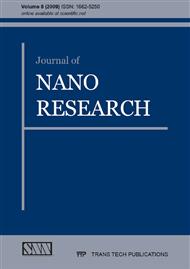[1]
H. Torvela and S. Leppävuori: Intern. High Technol. Ceram. Vol. 3 (1987), p.309.
Google Scholar
[2]
A. Cirera, A. Vila, A. Dieguez, A. Cabot, A. Cornet, and J.R. Morante: Sens. Actuators, B. Vol. 64 (2000), p.65.
Google Scholar
[3]
S. Chappel and A. Zaban: Sol. Energy Mater. Sol. Cells. Vol. 71 (2002), p.141.
Google Scholar
[4]
D. Aurbach, A. Nimberger, B. Markovsky, E. Levi, E. Sominsky, and A. Gedanken: Chem. Mater. Vol. 14 (2002), p.4155.
Google Scholar
[5]
M. Miyauchy, A. Nakajima, T. Watanable, and K. Hashimoto: Chem. Mater. Vol. 14 (2002), p.2812.
Google Scholar
[6]
Y. Rusen and W. Zhong. Lin: J. Am. Chem. Soc. Vol. 128 (2006) p.1466.
Google Scholar
[7]
A. P. Alivisatos: J. Phys. Chem. Vol. 100 (1996), p.13236.
Google Scholar
[8]
L.M. Cukov, T. Tsuzuki, and. McCormick : Scr. Mater. Vol. 44 (2001), p.1787.
Google Scholar
[9]
M. Ocaña, C.J. Serna, and E. Matijevic: Mater Lett. Vol. 12 (1991), p.32.
Google Scholar
[10]
K.C. Song, J.H. Kim: Powder Technol. Vol. 107 (2000), p.268.
Google Scholar
[11]
M. Tite,T. Pradell, and A. Shortland: Archeometry Vol. 50 (2008), p.67.
Google Scholar
[12]
J. Molera, T. Pradell, N. Salvadó, N., and M. Vendrell-Saz: J. Am. Ceram. Soc. Vol. 82 (1999), p.2871.
Google Scholar
[13]
C. Wang, B. Lu, J. Zuo, S. Zhang, S. Tan, M. Suzuki, and W.T. Chase: Nanostruct. Mater. Vol. 5 (1995), p.489.
Google Scholar
[14]
F. Morser, The Glass Industry. (1961), p.244.
Google Scholar
[15]
P. Hadsund: Stud Conserv. Vol. 38 (1993), p.3.
Google Scholar
[16]
J.M. F Navarro. El Vidrio. 3nd Ed., (CSIC publications, Madrid 2003).
Google Scholar
[17]
L. K Herrera, A. Duran, M. L Franquelo, M.C. Jimenez de Haro, A. Justo, J. L PerezRodriguez: J. Cult. Herit. (2008), p e41-e46.
Google Scholar
[18]
L.K. Herrera, A. Duran, M.L. Franquelo, A. Justo, and J.L. Perez-Rodriguez: J. Non-Cryst. Solids (2009) in press.
Google Scholar
[19]
L.K. Herrera, A. Duran, M.L. Franquelo, A. R González-Elipe, J. P Espinós, Rubio-Zuazo. J, A. Justo, and J.L. Perez-Rodriguez: Cent. Eur. J. Chem. Vol 7 (2009) pp.47-53.
DOI: 10.2478/s11532-008-0089-1
Google Scholar
[20]
I. De Ryck, E. Van Biezen, K. Leyssens, A. Adriaens, P. Storme, and F. Adams: J. Cult. Herit. Vol. 5 (2004), p.189.
DOI: 10.1016/j.culher.2003.10.002
Google Scholar
[21]
L. Robbiola, K. Rahmouni, C. Chiavari, C. Martini, D. Prandstraller, A. Texier, H. Takenouti, and P. Vermaut: Appl. Phys. A: Mater. Sci. Process. Vol. 92 (2008), p.161.
DOI: 10.1007/s00339-008-4468-4
Google Scholar
[22]
R. A Ramik, R. M Organ, and J. A Mandarino: Can. Mineral. Vol. 41 (2003), p.649.
Google Scholar
[23]
L.K. Herrera, A Duran, M. C Jimenez de Haro, J. L Perez-Rodriguez and A. Justo: Coalition Electronic Newsletter. Vol. 14 (2007) p.10.
Google Scholar
[24]
S. E Dunkle, J.R. Craig, J.D. Rimstidt, and W. R Lusardi: Geoarchaeology. Vol. 19 (2004), p.531.
Google Scholar
[25]
H. Strandberg, L-G Johansson, and O. Lindqvist: Werkst korros. Vol. 48 (1997), p.721.
Google Scholar
[26]
L. Robbiola, J-M Blengino, and C. Fiaud: Corros. Sci. Vol. 40 (1998), p (2083).
Google Scholar
[27]
J.L. Perez-Rodriiguez, A. Wiewiora, V. Ramirez-Valle, V., A. Durán, and L .A. PérezMaqueda, L. A: J. Phys. Chem. Solids. Vol. 68 (2007) p.1225.
Google Scholar
[28]
T. Krishnakumar, N. Pinna, K. Prasanna, K. Perumal, and R. Jayaprakash: Mater Lett. Vol. 62 (2008), p.3437.
Google Scholar
[29]
T.B. Massalsky (ed. ) in: Binary Alloys Phase Diagrams, Vol. 3 Edn. (ASM International, Metals Park, Ohio, 1992).
Google Scholar
[30]
V.F. Degtyareva: Phys. Rev. B: Condens. Matter. Vol. 59 (1999), p.6058.
Google Scholar
[31]
G.C. Che, M. Ellner, K. Schubert,: J. Mater. Sci. Lett. Vol 26 (1991) p.2417.
Google Scholar
[32]
X. Liujiang, Q. Dong, T. Xincun, and C. Chunjiao: Mater. Chem. Phys. Vol. 108 (2008), p.232.
Google Scholar
[33]
Y.D. Wang, C.L. Ma, H.D. Li, and S. Zhang: Mater. Chem. Phys. Vol. 107 (2008) p.248.
Google Scholar


